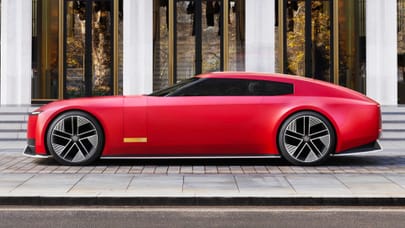
TG’s guide to concepts: the reborn Lotus Esprit V8
The spearhead of Lotus’s aborted regeneration was (almost) a true Ferrari rival


The story of Lotus’s hyper-ambitious reinvention project ought to be the subject of a film one day. Lord knows the 2010 Paris motor show already had the A-listers required. Mickey Rourke and Naomi Campbell unveiled concept car after concept car, revealing everything from a reborn Elise to a four-door Porsche Panamera rival and an uber-GT that’d take on Aston’s DB9 and the Bentley Continental GT.
Ex-Ferrari marketing chief and then new Lotus boss Dany Bahar’s message was, conversely, a simple one. If Lotus was to make its first-ever profit and become a long-term player in the fast car game, it needed to cease confining itself to lightweight track day fodder and diversify. Make luxury cars. Make supercars. Cars that would genuinely rival the best from Ferrari, Lamborghini, Porsche, and the then-unproven McLaren Automotive.
Advertisement - Page continues below
At the forefront of the charge was a familiar name: 'Esprit'. Lotus needed a new supercar, and the Esprit model wore the new design language well. Low, angular, cab-forward and angry, it eschewed flimsy aero for a solid, clean profile and offered a futuristic, driver-focused cabin where carbon fibre took priority from Lotus’ usual trademarks of aluminium and fibreglass. Against the then-ageing Gallardo, and the unknown MP4-12C, it looked potentially competitive. Lotus itself pitched it as a genuine Ferrari 458 Italia rival, and in 2010, rivals came no bigger or more complete – just as McLaren was soon to discover.
Though the Esprit was the new-age Lotus touted to be first into production (builds starting late 2013 and on sale in early 2014), in reality Lotus hadn’t nailed down the details. Details like ‘where will we build the car?’ and ‘what should power it?’ So, while plans and funds were secured for a new factory in Hethel, engineering minds turned to an engine. Long-term partners Toyota didn’t have anything that could offer the circa-600bhp needed for that kind of supercar at the time, but Toyota’s luxury spur Lexus certainly did. A plan was hatched to deploy the 5.0-litre, naturally aspirated V8 from the IS-F super-saloon into the middle of the Esprit, with power upped from its stock 417bhp.

Unfortunately, somewhere along the line it was decided that Lotus couldn’t very well go swaggering back into Supercar Alley brandishing a tuned-up Lexus saloon engine. And so, Lotus committed to produce its own, bespoke V8 motor. There was talk of a naturally aspirated version, then a twin-turbo model, and even a KERS electro-boost system to tie-in with Lotus getting back into F1. Yummy specs, but engine-creation is a heroically expensive, potentially ruinous thing to do. Just ask TVR. Oh, you can't.
Advertisement - Page continues below
Incredibly, it’s believed Lotus (which hadn’t built its own powerplant for decades) got the engine going. And more than that, it was apparently a good one. Allegedly, it completed massive amounts of testing on the static engine dyno, with power hitting the 600bhp target. Lotus then supposedly butchered an unsuspecting Ferrari 458 Italia, ripping out the standard 4.5-litre, 562bhp V8 and plugging in their own engine. That’s a smart idea: get to know the handling of your closest rival and test your new engine, without all but the most trained ears being able to spot something’s afoot. Against all the odds, it appeared Lotus would pull off its supercar comeback.

As we now know, it fell cruelly short and the mega-rejuvenation plan was shelved. Initially, it appeared parent company DRB-Hicom would pay the bills to get the Esprit to market in order to recoup some investment, even after binning the four other concepts, but it wasn’t to be. The new Esprit was cancelled relatively late in its development cycle, on 29 September 2014. Supposedly, the Ferrari-Lotus hybrid mule was dismantled or crushed to prevent what might have been ever seeing the light of day.

How a new Esprit may have faired in the modern field of Huracan, 488 GTB, R8 V10 and 720S, we’ll never know. However, there are shoots of good news from this sad tale. Not only did McLaren succeed in launching the MP4-12C at around the same time (and refining it into the 650S, 675LT) before replacing it with its new 710bhp contender; but Lotus survived too. And came back fighting.

Lotus funneled investment back into its heartland lightweight engineering, and has a refreshed range of world-class sports cars with handling from the gods to show for its efforts. It's successfully launched the Evora in the USA, and in 2016, actually made an operating profit. Now, it’s working on an SUV, alongside a fresh Elise for 2020. Here’s hoping the diversity push goes much more smoothly this time, or Hollywood will be calling…
Advertisement - Page continues below
Trending this week
- Car Review
BMW 1 Series
- Top Gear's Top 9
Nine dreadful bits of 'homeware' made by carmakers







